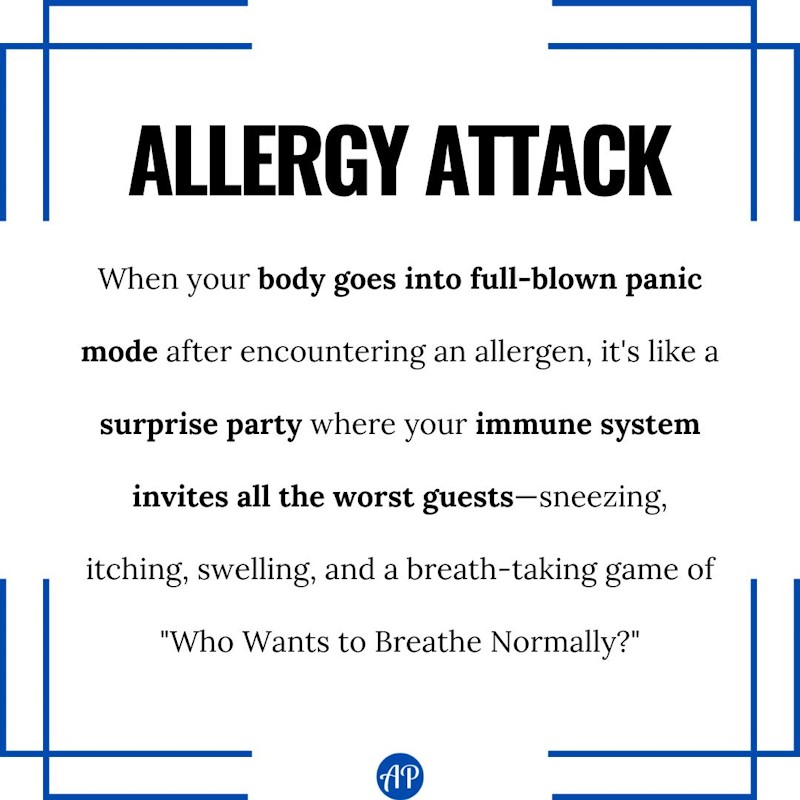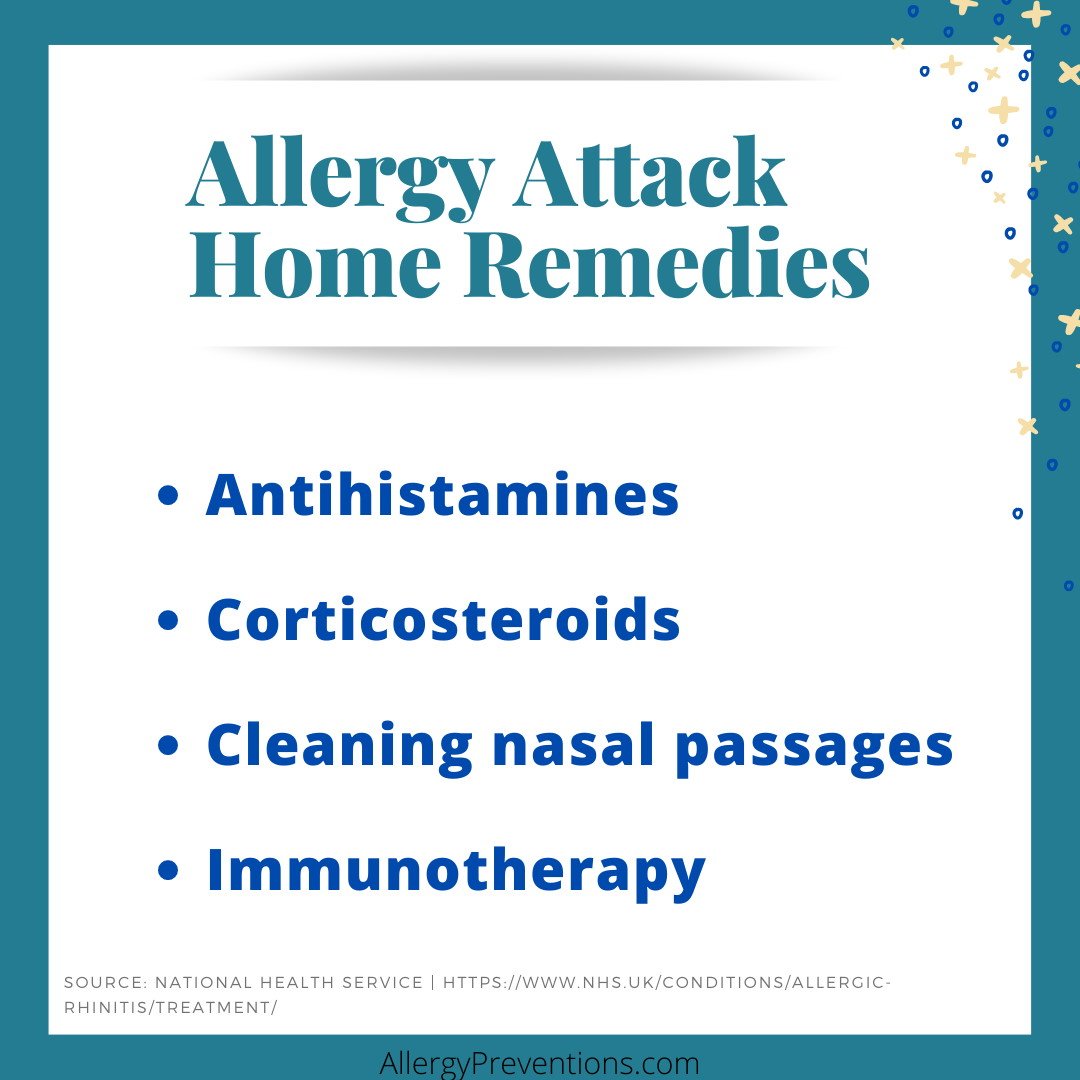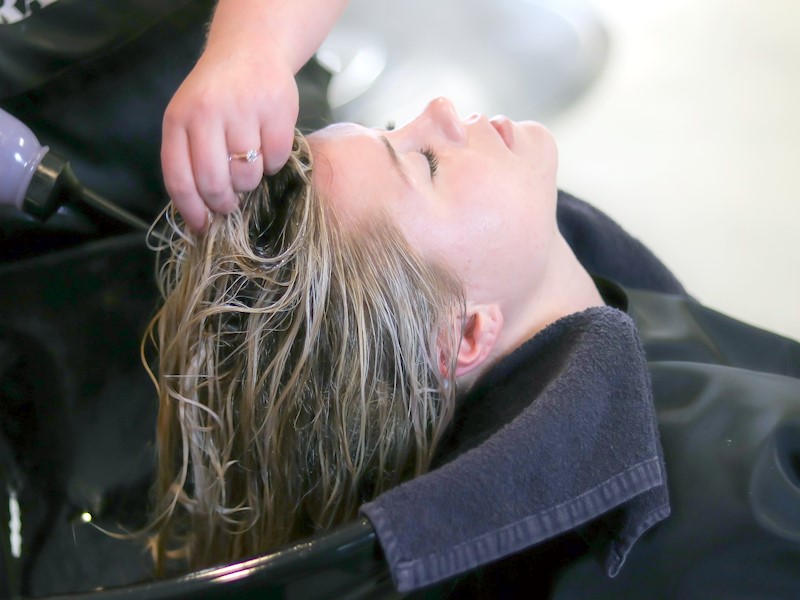An allergy attack can be a serious matter. This article will prepare you with the knowledge you need when learning about allergy attacks. During my research, I have found that there are not many in-depth guides that contain all the information you need about allergy attacks. So, I present to you your one-stop shop for learning the symptoms, remedies, facts, and more!

Allergies are the 6th leading cause of chronic illness in the U.S. with an annual cost in excess of $18 billion.”
ACAAI.org
I know a thing or two about allergy attacks because I have personally been “attacked” by allergies! My first attack was when I was living in Texas, which ended in a trip to the Emergency room (not fun). After that E.R. trip, I got allergy testing done, and I am allergic to everything environmental.
I hope that this information will better prepare you for allergy attacks and ultimately assist you in preventing future attacks.

As an Affiliate member, including Amazon, I may earn a commission from qualifying purchases.
Table of Contents
What is an Allergy Attack?
An allergy attack is your body’s reaction to a substance (allergen), resulting in an immune system response. With allergies, your immune system THINKS that substances like pollen, dander, mold, and dust mites are invaders. Your body goes to “attack” these invaders resulting in allergy symptoms, or an “allergy attack”.
Symptoms of an Allergy Attack

The symptoms of an allergy attack are different for everyone and are not always just sneezing and watery eyes. Here is a list of the most common allergy symptoms:
- Chest tightness
- Cough
- Diarrhea
- Dry, red, and/or cracked skin
- Itchy, red, watering eyes (conjunctivitis)
- Raised, itchy, red rash (hives or urticaria)
- Runny, or congested nose (allergic rhinitis)
- Shortness of breath
- Sneezing
- Stomach pain
- Swollen lips, tongue, eyes, or face
- Vomiting
- Wheezing
Additionally, there are many reports of allergies causing loss of taste, but this symptom is not considered to be very common.
Severe Allergy Attack Symptoms (Anaphylaxis)

Your symptoms can also take a turn for the worse. This list is of the more severe symptoms that can surface with a severe allergic reaction:
- Anaphylaxis
- Blue skin or lips
- Collapsing and losing consciousness
- Confusion
- Difficulty breathing
- Lightheadedness
- Swelling of the throat and mouth
Allergic reactions are a medical emergency that requires immediate treatment. Seek care promptly for your allergy symptoms. This information is not a substitute for professional medical care. Always consult with a healthcare professional regarding your specific situation and follow their instructions.
Causes of an Allergy Attack

An allergy attack is triggered when you are exposed to an allergen. An allergy is your body’s nonsensical response to a substance that is usually non-threatening (i.e. allergen). Many people are allergic to pollen, dust (dust mites), food, insect bites/stings, mold, animal dander, medications, perfumes, chemicals, and/or latex.
Common Allergy Types
The vast majority of allergies that someone experiences fall into one of these four categories:
- Seasonal allergies: Also known as hay fever or allergic rhinitis, these indoor/outdoor allergies are triggered by airborne allergens like pollen and mold spores.
- Food allergies: Certain foods can trigger a food allergy immune response, leading to symptoms such as hives, swelling, abdominal pain, and even anaphylaxis in severe cases.
- Pet allergies: Allergic reactions to pet dander, saliva, or urine can cause symptoms ranging from sneezing and itching to difficulty breathing.
- Drug allergies: Some individuals may develop allergies to specific medications, resulting in rashes, hives, or even life-threatening reactions.
Causes of an Allergy Attack at Night

The cause of an allergy attack at night will be sparked by what you are allergic to, the biggest culprit is dust mites. Although, there are many allergens that may cause allergy symptoms when going to bed.
Other factors that can lead to your symptoms being worse at night include your sleeping environment, room cleaning frequency, and hygiene practices.
Seasonal Allergy Attacks
Are you noticing that your allergy attacks are showing up seasonally? You may suffer from classic seasonal or environmental allergies. Here are the possible causes of allergies by season.
Winter

Winter allergy attacks can be caused by just about any allergen. Here are the most likely causes of your symptoms:
- Dander
- Dust mite
- Mold
- Tree pollen
Spring

Spring allergies tend to be the hardest hitting for most people because of the grass and weed growth season, and plants blooming. These are the main causes of spring allergy symptoms:
- Dander
- Dust mite
- Grass pollen
- Tree pollen
- Weeds
Summer

During the summer months, mold is not usually an issue for allergy sufferers, but this time of year is when there are high winds and lots of tree pollen. These are the most common allergy triggers in summer:
- Dander
- Dust mite
- Grass pollen
- Tree pollen
- Weed pollen
Fall

During the autumn months, most of the pollen allergens have quieted down, but the mold allergens are picking up speed. These are the top Fall allergen producers:
- Dander
- Dust mite
- Mold
- Tree pollen
Year-Round Allergies
Year-round allergies are something I am no stranger to. I am allergic to so many different things, that I have allergies all year. You might be in the same boat as well, and here are some possible causes.
Potential Causes of Allergies all year
- Dust mites
- Food allergies
- Insect stings or bites
- Pet dander
- Seasonal allergies
- Two or more “seasonal allergens” (i.e. pollen & mold)
Allergy Attack After Exercise

An allergy attack may be sparked by working out, this is rare, but still possible. There is a condition called Exercise-Induced Anaphylaxis (EIA), where you will develop allergy symptoms during an exercise or hours after.
This condition can become life-threatening and should be taken seriously. According to the American Medical Society for Sports Medicine, this condition is food-related 30-50% of the time. What this means is depending on what you ate before working out, may play a role in whether you experience EIA or exercise-induced allergies.
How long does an allergy attack last?
An allergy attack can last minutes to years, as an allergy attack may continue until you are no longer exposed to the allergen.
Short-Term Allergy Attack Example

You have a dander allergy and go to a friend’s house who has dogs. When you walk through the door your allergy symptoms start to flare up. At this point, you may turn around and go outside so your symptoms don’t get worse. You notice that when you are outside your symptoms are getting better. This allergy attack may have lasted 5 minutes.
Chronic Allergy Attack Example

You have a pollen allergy and your allergy testing confirms you are allergic to grass, weeds, and trees. No matter where you live, you are surrounded by something that flares up your allergies. You have been prescribed allergy medication, but you continue to have allergy symptoms. This is a chronic allergy attack.
How to Stop an Allergy Attack
Allergy attacks can leave us with miserable symptoms that we want to get rid of fast. Here are some pointers to stop an allergy attack fast:
- Get the allergen off of you (shower, change clothes)
- Remove yourself from the allergen
- Try an antihistamine
- Use a saline nasal rinse
If you are experiencing severe symptoms (anaphylactic symptoms) you need to call seek medical attention, including calling for emergency medical assistance, and potentially using your EpiPen.
Allergy Attack Home remedies

The NHS has compiled a list of self-help, allergy-attack home remedies. Here are some home remedies that can help with a minor allergy attack.
- Antihistamines
- Corticosteroids
- Cleaning nasal passages (nasal rinse)
- Immunotherapy (long-term)
How to Prevent Allergy Attacks
Preventing allergy attacks is the main goal for us allergy sufferers. The best way for you to effectively control your allergies is to know what you are allergic to and do your best to avoid that allergen.
The following pointers will help you navigate through seasonal allergies in the most effective way by allergen type.
Preventing Pollen Attacks
Pollen can hide out in multiple places around your house, and cause allergy symptoms day and night. Consider taking these steps to find relief:

Keep windows closed

Keeping your windows closed during the pollen season may drastically decrease your allergy attacks at night. Open bedroom windows (or anywhere in the house) invite the pollen right in. Window screens are not dense enough to stop pollen from coming inside.
Change your clothes

Changing your clothes when you get in the house prevents the pollen from settling in your furniture and carpets. The great outdoors is where the majority of pollen comes from, when you go outside you are unknowingly picking up pollen hitchhikers that you bring into your home.
Wash the pollen from your hair

Your hair can be a safe haven for pollen. Ensure you are rinsing your hair to wash the pollen away so you do not bring it into your bed or onto your pillow. If you do not rid your hair of pollen, the pollen will be near your face all day long, causing you to suffer from allergy symptoms.
Wash your bedding

Allergy attacks that only occur at night might be due to dirty linens or a contaminated mattress. Wash your bedding to remove any allergens that may be trapped and consider getting a mattress cover to prevent all allergens from hanging out in your mattress.
Remove dust

Dust is made up of skin cells, dust mites, pollen, bacteria (and a bunch more things). When you remove the dust, you are removing allergens. When dusting, use something like a Swiffer duster which locks in the dust with static.
Traditional feather dusters are not advised, they just make the dust airborne and do not remove it. Alternatively, you can get a damp washcloth and wipe down the dusty surfaces.
Preventing Mold Attacks

Molds like to grow in comfortable temperatures with high humidity. This mold-growing environment is typically found in your bathroom or nearby bedroom. Here are a few tips to prevent mold from growing or spreading in your home, which could be the reason for your allergy attacks at night.
Preventing Mold Allergies
By controlling the moisture, you control the mold! Take the steps needed to stop mold growth:
- Use the bathroom vent fan when you are showering
- Find the source of any water leaks and stop them
- Use a dehumidifier if your humidity is over 60%
Dehumidifiers can help big time
Dehumidifiers are mold’s worst enemy, and here’s why. Mold loves moisture, it can’t get enough of it. But dehumidifiers, they swoop in and save the day by sucking that excess moisture right out of the air.
By keeping the humidity level between 30 and 50 percent, which is the sweet spot, dehumidifiers make it hard for mold to survive. Mold likes it wet and juicy, but at this humidity range, it’s like trying to grow a cactus in a rainforest. It’s just not going to happen.

A dehumidifier like this Vellgoo is one of the best-rated to get your humidity levels below 60%. If you have high humidity levels in your home, and you suffer from mold allergies, you need to check this baby out.
Preventing Dust Mite Attacks

Dust mites like soft fluffy areas like your mattress or stuffed animals, which is why you may have an allergic reaction only when indoors or at night. To reduce dust mite allergies consider the following:
- Dust often ( and wear a mask)
- Lower humidity levels (dehumidifier)
- Minimize clutter that collects dust
- Remove rugs
- Replace carpets
- Replace your HVAC system filter
- Use a HEPA air filter/Air purifier
- Use a mattress/box spring protector
- Wash bedding in hot (130F+) water weekly
- Wash or get rid of curtains
Preventing Pet Dander Attacks

The AAFA explains that there are no truly hypoallergenic pets, as the dander is a protein in your pet’s saliva, urine, and on their skin. Not just in their fur. Pet fur can also bring pollen, dust, mold spores, and other allergens into the house from the outdoors.
Tips For Reducing Pet Dander
- Clean your bedding
- Clean or replace carpets
- Keep pets out of your bedroom
- Remove rugs
- Replace the HVAC system filter
- Use a vacuum with a HEPA filter
- Wash your pet often to remove stuck allergens
- Wear a mask when cleaning/dusting
Use an Air purifier For All Airborne Allergens
Air purifiers use a High-Efficiency Particulate Air (HEPA) filter which removes 99.97% of all airborne contaminants including allergens that cause allergy attacks. You will need to dust your home less often, and you will be breathing healthy air the first day you set up your air purifier!
What an Air Purifier Removes

A High-Effeciency Particulate Air (HEPA) purifier improves the overall air quality by removing contaminants from the air. A HEPA purifier with a carbon filter can remove the following:
- Any airborne particles 0.3 microns or larger
- Bacteria
- Chemicals
- Dander
- Dust
- Dust mites
- Materials that “off-gas”
- Odors
- Pollen
- Smoke
- Viruses
- Violent Organic Compounds (VOCs)

We have 4 purifiers around the house right now. Our favorite for the bedrooms is our Levoit Core™ Mini (pictured), which we got on Amazon.
For the common areas of the house, we use the WINIX 5500-2, which is great for large areas of the home. If you are interested in the WINIX, check out our WINIX review, or swing by Amazon for more info.
Check these out next:
Allergies and Genes: Are Allergies Genetic?
